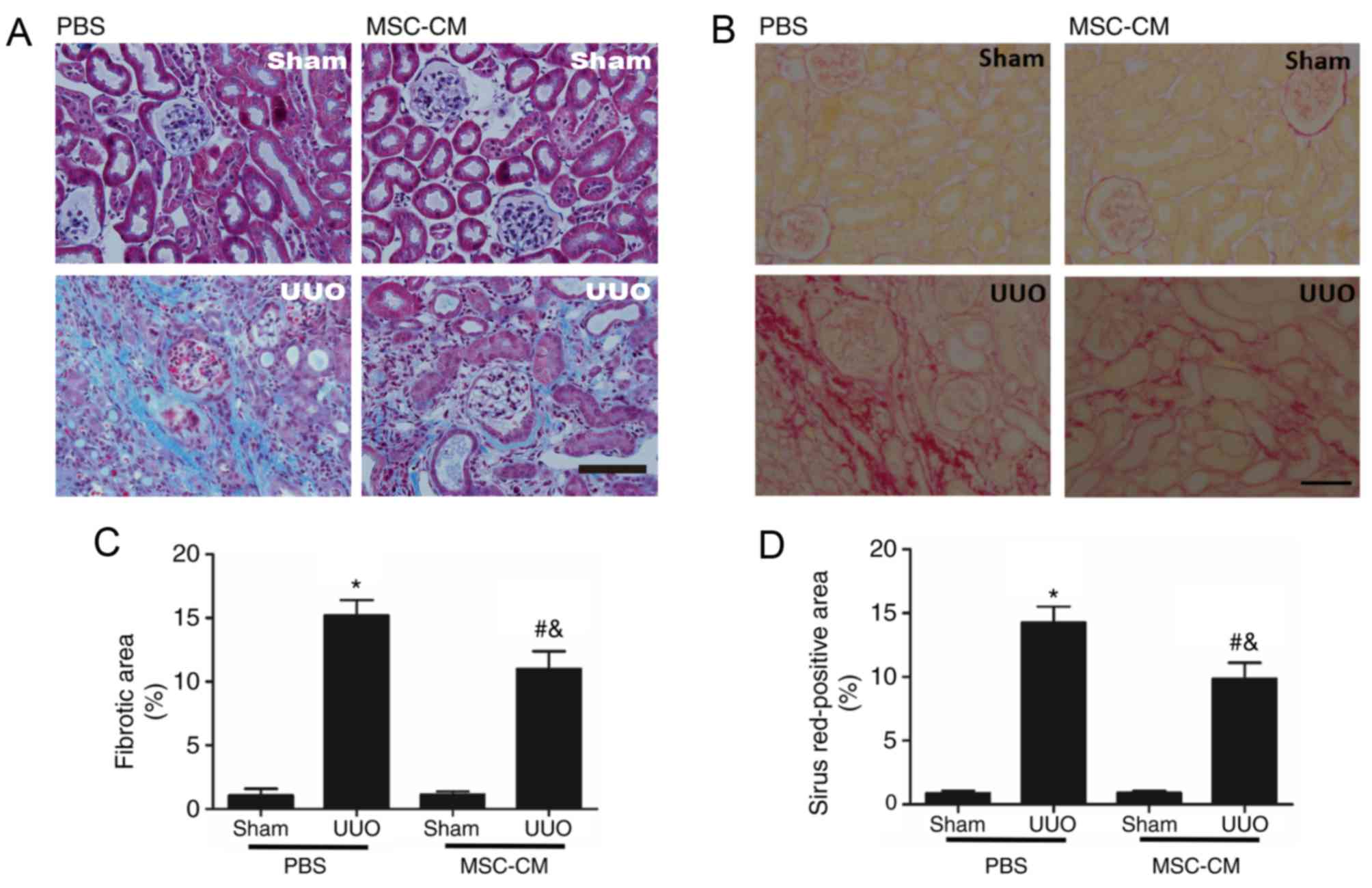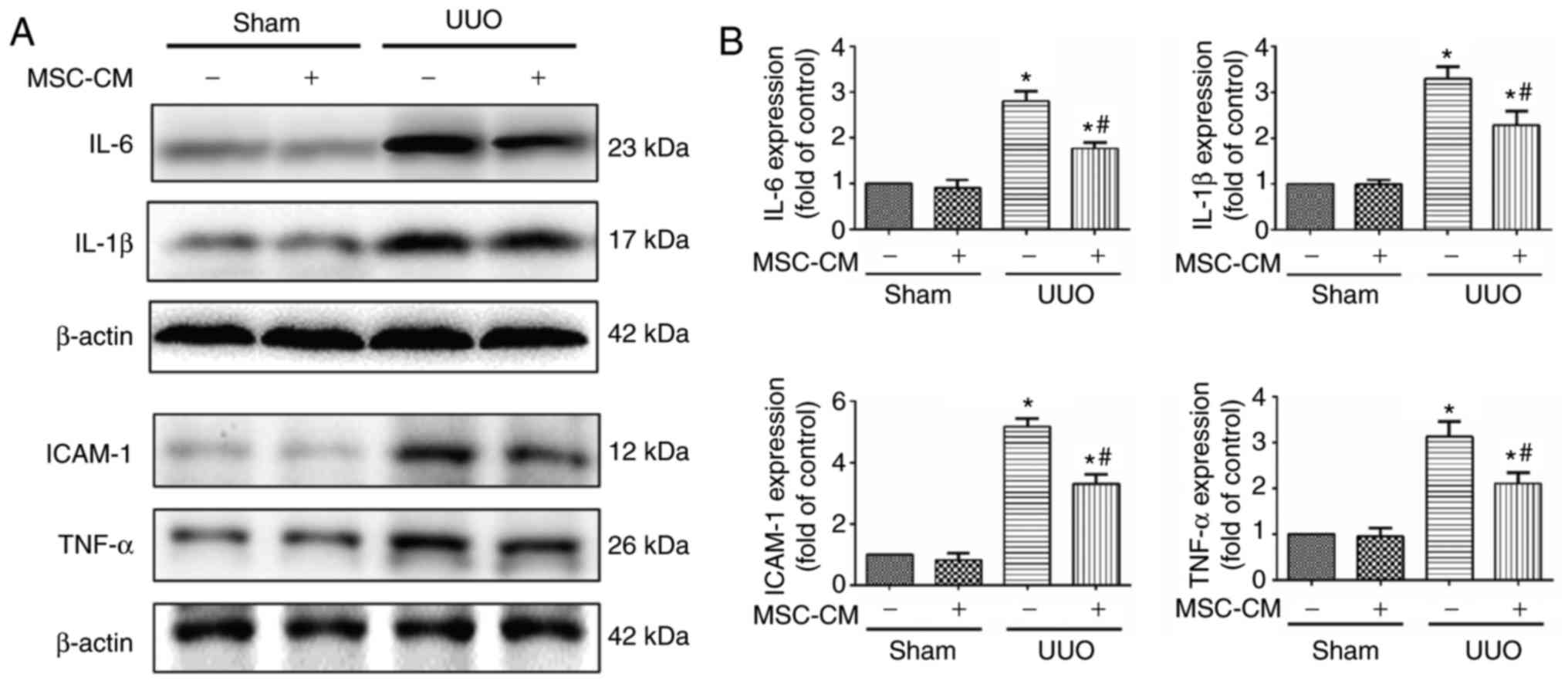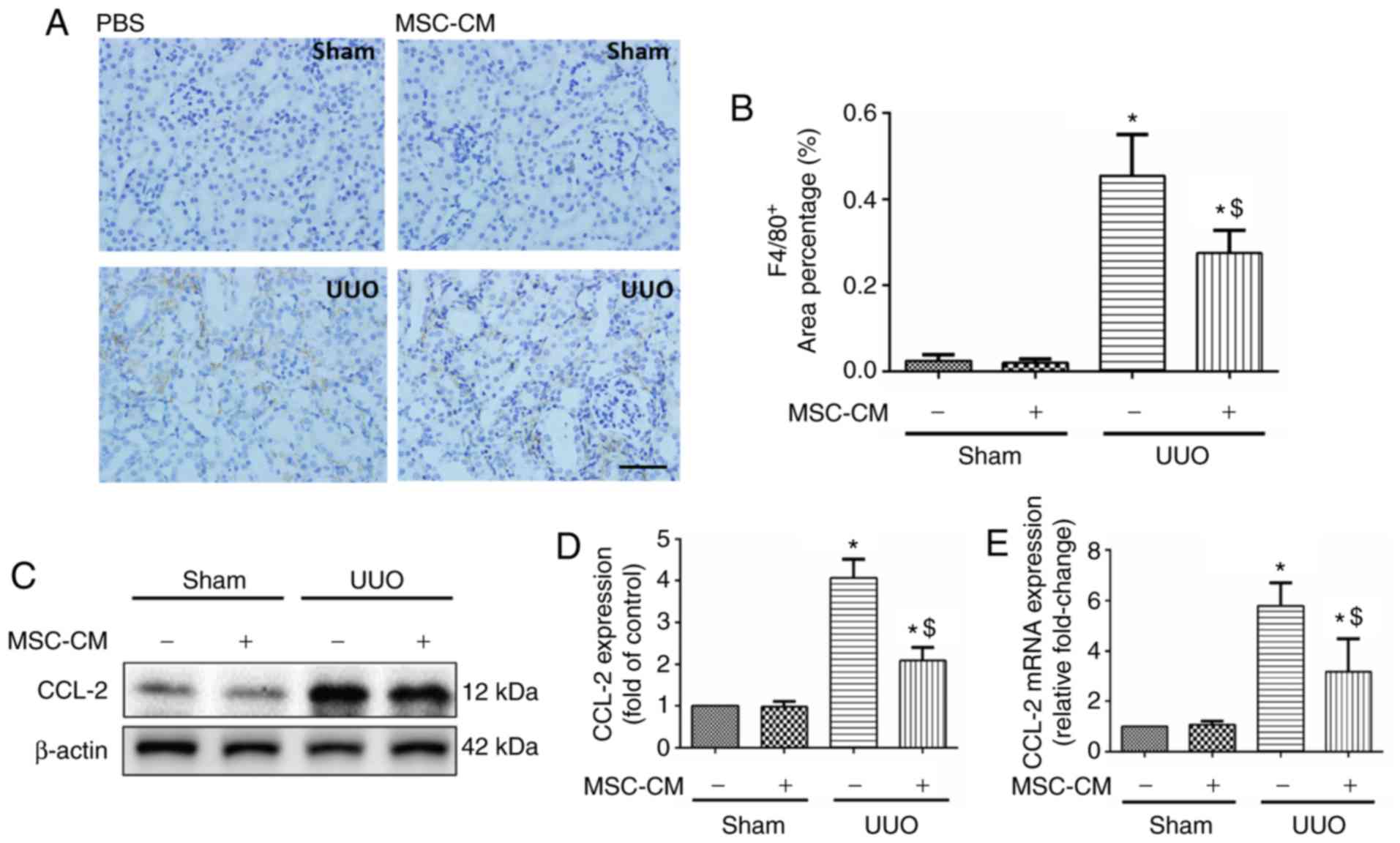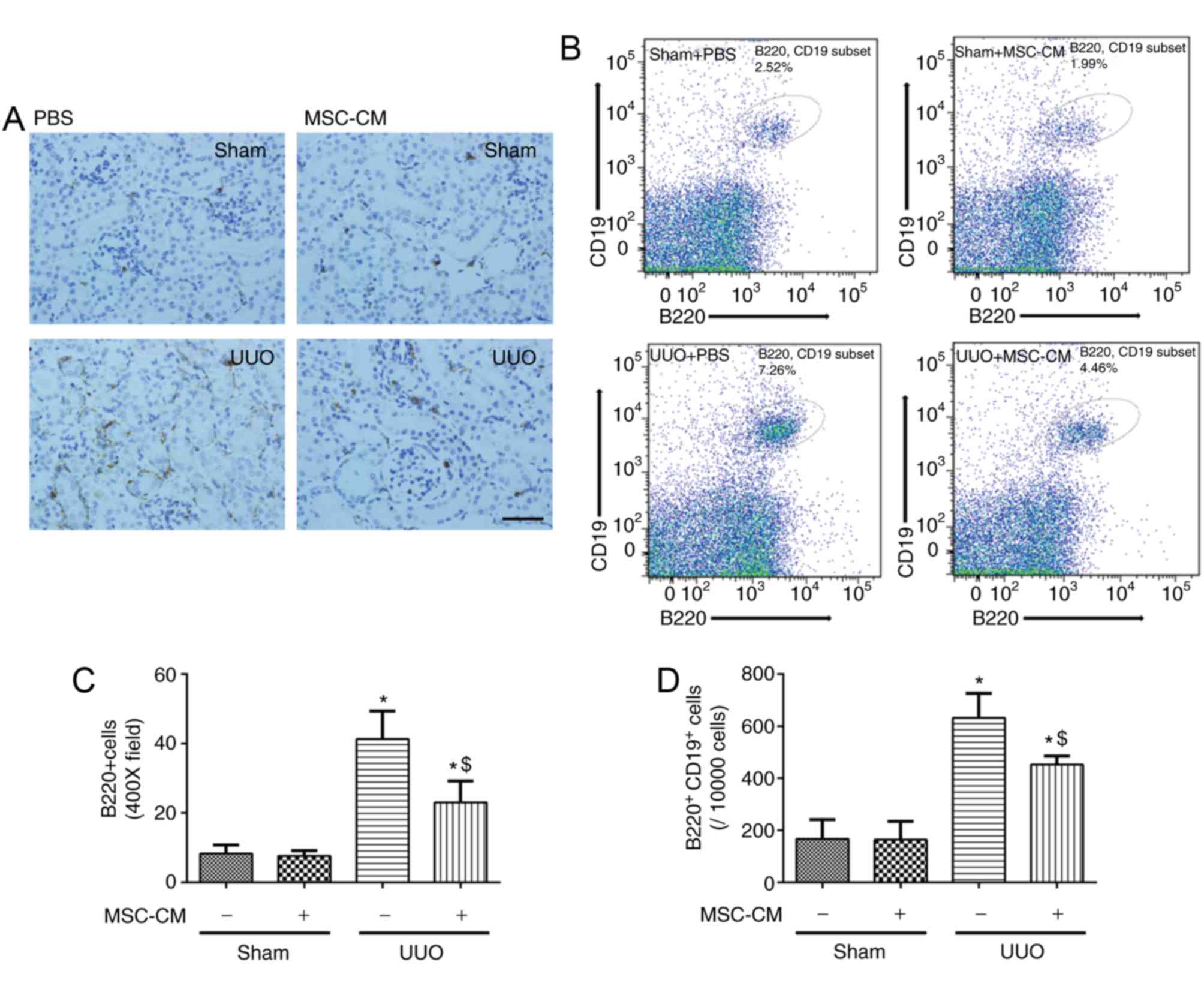Bone marrow‑derived mesenchymal stem cell‑conditioned medium attenuates tubulointerstitial fibrosis by inhibiting monocyte mobilization in an irreversible model of unilateral ureteral obstruction
- Authors:
- Published online on: April 5, 2018 https://doi.org/10.3892/mmr.2018.8848
- Pages: 7701-7707
-
Copyright: © Zheng et al. This is an open access article distributed under the terms of Creative Commons Attribution License.
Abstract
Introduction
As the common end stage of all progressive chronic kidney diseases, renal interstitial fibrosis is defined as an excessive infiltration of leucocytes and deposition of extracellular matrix, leading to the impairment of renal function, destruction of kidney structure and vicious progression to renal failure (1). Research advances regarding this progressive disease have been made; however, patients with end-stage renal disease tend to be dialysis-dependent (2).
Increasing efforts to investigate novel therapeutic strategies to hinder the development of renal interstitial fibrosis have been conducted. In vivo and in vitro studies have suggested that bone marrow-derived mesenchymal stem cell (BMSC)-based therapy produced significant renoprotective effects by reducing renal infiltration of inflammatory cells, glomerulosclerosis and fibrogenesis (3,4). The therapeutic property was mainly attributed to the paracrine effect and immunomodulatory response (5,6); however, allogenic MSC injection may also lead to various problems, including tumorigenesis, maldifferentiation and immune incompatibility (7–10).
Therefore, MSC-conditioned media (MSC-CM), which is rich in cytokines secreted by MSCs, is of primary research interest. Evidence has confirmed the protective effects of MSC-CM in various models (11,12); inhibition of apoptosis, inflammation, cell proliferation and epithelial-mesenchymal transition are all potential mechanisms (9). B cell-dependent immune responses were previously reported to serve a vital role throughout the renal fibrotic process; however, research focusing on the involvement of MSC-CM in this immunoregulatory pattern is limited (13).
In the present study, the model of unilateral ureteral obstruction (UUO) was employed and the therapeutic role of MSC-CM in renal fibrosis was investigated. MSC-CM treatment was demonstrated to attenuate renal fibrosis by hindering B cell-dependent immune responses following UUO in the present study.
Materials and methods
MSC isolation and preparation of MSC-CM
Primary MSCs were isolated from C57BL/6J mice (n=60, male; 8 weeks of age, 20–25 g) by flushing the femurs, and were cultured with Dulbecco's modified Eagle's medium (DMEM; Sigma-Aldrich; Merck KGaA, Darmstadt, Germany) supplemented with 10% fetal bovine serum (Gibco; Thermo Fisher Scientific, Inc., Waltham, MA, USA). Mice were maintained in air-filtered units at 21±2°C and 50±15% relative humidity under a 12 h light/dark cycle during the entire experiment. Mice were provided with rodent food and sterile water ad libitum. MSC-CM was prepared as described previously (14). MSC plates (80% confluence) were incubated with serum-free DMEM low-glucose for 24 h at 37°C. Supernatants from each plate were then collected and centrifuged at 500 × g at 4°C for 5 min. For each animal, 300 µl of conditioned medium generated by approximately 5.0×106 cells were injected intraperitoneally (i.p.). The present study was approved by the ethics committee of the People's Hospital of Rizhao (Rizhao, China).
UUO and injection of MSC-CM
All C57BL/6J mice (male, 8 weeks of age) were purchased from the Model Animal Research Center of Nanjing University (Nanjing, China). Mice were divided into four experimental groups: Sham-operated and PBS treated (Sham + PBS), sham-operated and MSC-CM treated (Sham + MSC-CM), UUO model and PBS treated (UUO + PBS), and UUO model and MSC-CM treated (UUO + MSC-CM) mice (n=12 for each group). Surgical UUO or a sham operation was performed as previously described (15) for UUO and sham groups, respectively. Briefly, the mice were carefully anesthetized using sodium pentobarbital. Following satisfactory anesthesia, a 1 cm ventral incision was made at the abdominal midline, and the left ureter and kidney were dissociated, and the left proximal ureter was exposed and ligated at two separate locations; sham-operated mice underwent identical exposure without ligation. The incision was then closed using polypropylene sutures, and the mice were allowed to recover from anesthesia. Following surgery, animals received MSC-CM (300 µl) or PBS (300 µl) i.p., which was repeated 3 days later as previously described (16,17). Flow cytometry and histological assessments were performed at days 3 and 14 following surgery, respectively. Prior to collection of tissue, mice were fasted overnight and anesthetized with 1.5% pentobarbital sodium (60 mg/kg i.p.; Shanghai XiTang Biotechnology Co., Ltd., Shanghai, China). All anaesthetized mice underwent thorax opening and heart exposure. Following the conduction of circulatory system perfusion with heparinized PBS, mice were sacrificed and then the left kidneys were removed for further analysis.
Histological analysis
The left kidney of each mouse was collected and fixed in 10% formaldehyde as previously described (13). Masson's trichrome and Sirius Red staining procedures (at 25–28°C for 20 min) were performed on 6 µm sections of these paraffin-embedded kidneys for the evaluation of the severity of tubulointerstitial fibrosis. To determine the accumulation of monocytes/macrophages and B lymphocytes, sections of the kidney were also used for immunohistochemical analysis with the following antibodies: Anti-F4/80 (1:200; ab6640; Abcam, Cambridge, UK) and anti-B220 (1:100; ab64100; Abcam) antibodies. Sections were blocked with 5% bovine serum albumin (Sangon Biotech, Shanghai, China) at 25–28°C for 20 min and then incubated with the primary antibodies overnight at 4°C. Following incubation with horseradish peroxidase (HRP)-conjugated secondary antibody (1:1,000; ab6734; Abcam) at 25–28°C for 20 min, sections were incubated with 3,3′-diaminobenzidine. The diaminobenzidine reaction was conducted for ~5 min at 25–28°C. For each section, 10 non-consecutive visual fields were randomly selected and captured with a light microscope (magnification, ×400, Olympus Corporation, Tokyo, Japan). Images were quantitatively analyzed using Image-Pro Plus 6.0 (Media Cybernetics, Inc., Rockville, MD, USA).
Flow cytometry
Kidney samples were prepared as previously described (13). Briefly, all anaesthetized mice underwent thorax opening. The heart was exposed and a circulatory system perfusion with heparinized PBS was conducted. Renal cortex tissues were then immediately collected, minced and placed into RPMI 1640 medium (Thermo Fisher Scientific, Inc.) containing 40 mg/ml Liberase TM (Roche Diagnostics, Basel, Switzerland) and 8.5 U/ml DNase I (Roche Diagnostics) for 40 min at 37°C. Cells were washed with serum-free RPMI 1640 medium and resuspended in FACS buffer (BD Biosciences, Franklin Lakes, USA) following the addition of red blood cell lysis buffer (BD Biosciences) to exclude erythrocytes. To quantitatively analyze the number of leucocytes, the single cell suspensions were labelled with anti-B220-allophycocyanin (1:100; 17-0452-81; Thermo Fisher Scientific, Inc.) and anti-CD19-phycoerythrin (1:100; 557399; BD Pharmingen; BD Biosciences) for 30 min in the dark at 4°C prior to washing with FACS buffer. Multicolour flow cytometry was performed using a flow cytometer (FACSAriaIII; BD Biosciences) and data was analyzed using FlowJo software version 7.6 (FlowJo LLC, Ashland, OR, USA).
Preparation of cDNA and reverse transcription-quantitative polymerase chain reaction (RT-qPCR)
Total RNA from harvested kidneys was extracted using TRIzol® reagent (Invitrogen; Thermo Fisher Scientific, Inc.) according to the manufactures' protocols. RT was performed using a First-strand cDNA Synthesis kit (Invitrogen; Thermo Fisher Scientific, Inc.) according to the manufacturer's protocols. The PCR cycling conditions were as follows: Predenaturation at 95°C for 10 min, 40 cycles at 95°C for 15 sec, 60°C for 1 min and 72°C for 20 sec, and a final extension at 60°C for 5 min. qPCR was performed with Power SYBR® Green PCR Master Mix in a StepOne system (Applied BioSystems; Thermo Fisher Scientific, Inc.). The sequences of the primers for CC chemokine ligand-2 (CCL-2) were as follows: 5′-TTAAAAACCTGGATCGGAACCAA-3′ (forward) and 5′-GCATTAGCTTCAGATTTACGGGT-3′ (reverse). Gene expression levels were normalized with GAPDH [5′-GGTGAAGGTCGGTGTGAACG-3′ (forward) and 5′-CTCGCTCCTGGAAGATGGTG-3′ (reverse)] and data were quantified and analyzed with StepOne software v2.1 (Thermo Fisher Scientific, Inc.).
Western blotting
Renal tissue samples were used for the extraction of protein and homogenized in ProteoJET Mammalian Cell Lysis Reagent (Fermentas; Thermo Fisher Scientific, Inc.). Total proteins were quantified using the bicinchoninic acid method. Western blotting was performed as previously described (18). Proteins (30 µg/lane) were separated by 10% SDS-PAGE. The protein was transferred to a polyvinylidene floride membrane and blocked with 5% skimmed milk for 2 h at 25–28°C. Tumor necrosis factor (TNF)-α (1:1,000; ab66579, Abcam), interleukin (IL)-1β (1:1,000; sc-7884, Santa Cruz Biotechnology, Inc., Dallas, TX, USA), intercellular adhesion molecule 1 (ICAM-1; 1:1,000; ab179707, Abcam), IL-6 (1:1,000; ab208113, Abcam) were incubated with the membrane overnight at 4°C. Horseradish peroxidase-labelled goat anti-rabbit secondary antibody (1:5,000; cat. no. 7074; Cell Signaling Technology, Inc., Danvers, MA, USA) was added for incubation at room temperature for 1 h, followed by addition of an enhanced chemiluminescence luminous fluid (Beyotime Institute of Biotechnology, Haimen, China) at room temperature for 3 min. The gel was photographed using a gel imaging system. β-actin (1:2,000; cat. no. 4970; Cell Signaling Technology, Inc.) was used as a house-keeping reference. Densitometric analysis of the western blot results was performed with Image J version 1.48 software (National Institutes of Health, Bethesda, MD, USA).
Statistical analysis
Data were analyzed using SPSS software, version 15.0 for Windows (SPSS Inc., Chicago, IL, USA). Results are presented as the mean ± standard deviation. The statistical analysis for the determination of differences in the measured properties between groups was accomplished using one-way analysis of variance followed by a Turkey's post hoc test. P<0.05 was considered to indicate a statistically significant difference.
Results
MSC-CM treatment attenuates UUO-induced fibrosis and renal inflammation
Masson's trichrome and Sirius Red staining was performed to assess fibrotic alterations induced by UUO. The blue-stained (Masson's trichrome-positive) and red-stained (Sirius Red-positive) areas, associated with collagen deposition, were markedly increased in UUO mice compared with sham-operated groups. Notably, treatment with MSC-CM effectively protected the injured kidney from tubulointerstitial fibrosis following UUO, compared with the UUO + PBS group (Fig. 1).
Throughout the procession of UUO-associated fibrogenesis, local inflammatory responses serve a vital role. Therefore, the expression levels of numerous key proinflammatory factors 14 days following the UUO operation were analyzed via western blotting. Statistical analysis revealed that MSC-CM treatment significantly decreased renal expression of TNF-α, IL-1β, IL-6 and ICAM-1 following UUO compared with the UUO + PBS group. In addition, the expression levels of TNF-α, IL-1β, IL-6 and ICAM-1 were significantly lower in the sham groups compared with in the UUO groups (Fig. 2).
MSC-CM treatment reduces intrarenal infiltration of monocytes/macrophages following UUO
Monocytes/macrophages are a primary source of proinflammatory factors, and their influx into the renal interstitium is deemed one of the typical features of kidney injury. Analysis of the immunohistochemical results revealed no alterations in the number of infiltrated F4/80-positive cells between PBS and MSC-CM-treated sham mice. Notably, MSC-CM-treated ones revealed a significant reduction in monocytic infiltration into the kidney 3 days following UUO surgery (Fig. 3A and B).
MSC-CM treatment decreases the expression of local CCL-2 in UUO kidneys
CCL-2, also known as MCP-1, is a member of CC-family chemokines. Several studies have reported that CCL-2 serves a critical role in the mobilization and relocation of inflammatory cells in response to UUO injury (13,19,20). To investigate the potential mechanisms associated with the effects of MSC-CM, the expression levels of CCL-2 were analyzed via western blotting and RT-qPCR. As revealed by western blotting, UUO resulted in the upregulation of CCL-2, which was attenuated by MSC-CM treatment (Fig. 3C and D). This result was further verified by RT-qPCR (Fig. 3E).
MSC-CM treatment alleviates mature B lymphocyte infiltration into the kidneys following UUO
B lymphocytes (B220+ and/or CD19+ cells) are a primary source of renal CCL-2 following UUO, particularly during the early stages. Mice were sacrificed for immunohistochemistry and flow cytometry 3 days following surgery. According to the immunohistochemical analysis, obstructed kidneys suffered greater infiltration of B220+ B lymphocytes compared with sham-operated groups. This effect was markedly inhibited by MSC-CM treatment (Fig. 4A and B). Additionally, the results of flow cytometry demonstrated that staining B cells with both anti-B220 and anti-CD19 antibodies, produced a similar effect (Fig. 4C and D).
Discussion
Previous studies have reported the beneficial effects of MSC-CM administration in modulating renal expression of cytokines associated with inflammation and cell proliferation. Immune cells, including monocytes/macrophages, B and T cells, and mast cells, are also considerable participants in the initiation and progression of renal fibrosis (21–23); however, it is unclear whether MSC-CM exerts an extensive impact on the regulation of intrarenal infiltration of lymphocytes following UUO. The present study revealed a protective effect of MSC-CM in attenuating fibrosis. In this process of treatment, the mobilization of monocytes was efficiently weakened by MSC-CM administration.
Abundant evidence has established that excess inflammation is an essential part of host defense mechanisms following tissue injury (24). By producing various inflammatory cytokines, monocytes/macrophages serve a considerable role in the process of post-injury fibrogenesis. Once induced, the progression of the fibrotic process may increase over time, and established fibrosis can seldom be reversed. Therefore, it is a great challenge to intervene from the initial phase and throughout the whole process of the disease. For UUO mice, MSC-CM treatment led to a reduced infiltration of renal monocytes/macrophages, and a decreased expression of pro-inflammatory factors in damaged kidneys, suggesting that MSC-CM may have protected against fibrotic progression by rebalancing the inflammatory response following UUO, particularly at the early stages of pathogenesis.
The reduction of monocytic infiltration and proinflammatory cytokines is most likely a consequence that is associated with the B cell-mediated immune responses. The present study demonstrated that MSC-CM treatment attenuated the upregulation of CCL-2 induced by UUO. CCL-2, also known as monocyte chemotactic protein 1, is ubiquitously expressed in a large variety of cell types, including smooth muscle cells, tubular cells, podocytes, mesangial cells and infiltrated leucocytes (25). Via the interaction with CC chemokine receptor-2, CCL-2 mediates the transmigration and influx of inflammatory monocytes into impaired kidneys (26,27). It has previously been demonstrated that early-stage infiltrated B cells are one of the major producers of CCL-2 in the damaged renal tissue (13). The results of the present study revealed that obstructed kidneys exhibited increased incidence of mature B lymphocytic infiltration compared with the sham-operated groups. This effect was significantly alleviated by MSC-CM treatment. These results reinforced the suggestion that MSC-CM may be a potent regulator and option for the treatment of renal immuno-imbalance and interstitial fibrosis following acute injury.
In conclusion, the present study suggested that the administration of MSC-CM ameliorated the intrarenal infiltration of proinflammatory monocytes/macrophages, the level of inflammation associated with renal fibrosis and subsequent fibrotic progression in mice subjected to UUO. The therapeutic effect of MSC-CM may possibly be attributed to the reduced recruitment of B lymphocytes and expression of CCL-2.
Acknowledgements
We are grateful for the assistance of physicians from the Departments of Laboratory Medicine and Nephrology, the People's Hospital of Rizhao (Rizhao, China).
Funding
The present study was supported by Discipline Development Fund from the People's Hospital of Rizhao.
Availability of data and materials
The datasets used and/or analyzed during the current study are available from the corresponding author on reasonable request.
Authors' contributions
JZ and QW produced the main manuscript text and prepared all the figures and tables. JP participated in the production of the manuscript and contributed to the research design. XS and WL participated in data analysis. All the authors discussed and agreed on the results, and read and approved the final manuscript.
Ethics approval and consent to participate
The present study was approved by the ethics committee of the People's Hospital of Rizhao (Rizhao, China).
Consent to publication
Not applicable.
Competing interests
The authors declare that they have no competing interests.
References
|
Liu Y: Cellular and molecular mechanisms of renal fibrosis. Nat Rev Nephrol. 7:684–696. 2011. View Article : Google Scholar : PubMed/NCBI | |
|
Liu X and Dai C: Advances in understanding and management of residual renal function in patients with chronic kidney disease. Kidney Dis (Basel). 2:187–196. 2017. View Article : Google Scholar : PubMed/NCBI | |
|
Bianco P, Cao X, Frenette PS, Mao JJ, Robey PG, Simmons PJ and Wang CY: The meaning, the sense and the significance: Translating the science of mesenchymal stem cells into medicine. Nat Med. 19:35–42. 2013. View Article : Google Scholar : PubMed/NCBI | |
|
Monsel A, Zhu YG, Gennai S, Hao Q, Liu J and Lee JW: Cell-based therapy for acute organ injury: Preclinical evidence and ongoing clinical trials using mesenchymal stem cells. Anesthesiology. 121:1099–1121. 2014. View Article : Google Scholar : PubMed/NCBI | |
|
Gnecchi M, Zhang Z, Ni A and Dzau VJ: Paracrine mechanisms in adult stem cell signaling and therapy. Circ Res. 103:1204–1219. 2008. View Article : Google Scholar : PubMed/NCBI | |
|
Duffield JS and Bonventre JV: Kidney tubular epithelium is restored without replacement with bone marrow-derived cells during repair after ischemic injury. Kidney Int. 68:1956–1961. 2005. View Article : Google Scholar : PubMed/NCBI | |
|
Jeong JO, Han JW, Kim JM, Cho HJ, Park C, Lee N, Kim DW and Yoon YS: Malignant tumor formation after transplantation of short-term cultured bone marrow mesenchymal stem cells in experimental myocardial infarction and diabetic neuropathy. Circ Res. 108:1340–1347. 2011. View Article : Google Scholar : PubMed/NCBI | |
|
Kunter U, Rong S, Boor P, Eitner F, Müller-Newen G, Djuric Z, van Roeyen CR, Konieczny A, Ostendorf T, Villa L, et al: Mesenchymal stem cells prevent progressive experimental renal failure but maldifferentiate into glomerular adipocytes. J Am Soc Nephrol. 18:1754–1764. 2007. View Article : Google Scholar : PubMed/NCBI | |
|
da Silva AF, Silva K, Reis LA, Teixeira VP and Schor N: Bone Marrow-derived mesenchymal stem cells and their conditioned medium attenuate fibrosis in an irreversible model of unilateral ureteral obstruction. Cell Transplant. 24:2657–2666. 2015. View Article : Google Scholar : PubMed/NCBI | |
|
van Koppen A, Joles JA, van Balkom BW, Lim SK, de Kleijn D, Giles RH and Verhaar MC: Human embryonic mesenchymal stem cell-derived conditioned medium rescues kidney function in rats with established chronic kidney disease. PLoS One. 7:e387462012. View Article : Google Scholar : PubMed/NCBI | |
|
Huang B, Cheng X, Wang H, Huang W, la Ga Hu Z, Wang D, Zhang K, Zhang H, Xue Z, Da Y, et al: Mesenchymal stem cells and their secreted molecules predominantly ameliorate fulminant hepatic failure and chronic liver fibrosis in mice respectively. J Transl Med. 14:452016. View Article : Google Scholar : PubMed/NCBI | |
|
Ohnishi S, Sumiyoshi H, Kitamura S and Nagaya N: Mesenchymal stem cells attenuate cardiac fibroblast proliferation and collagen synthesis through paracrine actions. FEBS Lett. 581:3961–3966. 2007. View Article : Google Scholar : PubMed/NCBI | |
|
Han H, Zhu J, Wang Y, Zhu Z, Chen Y, Lu L, Jin W, Yan X and Zhang R: Renal recruitment of B lymphocytes exacerbates tubulointerstitial fibrosis by promoting monocyte mobilization and infiltration after unilateral ureteral obstruction. J Pathol. 241:80–90. 2017. View Article : Google Scholar : PubMed/NCBI | |
|
Aslam M, Baveja R, Liang OD, Fernandez-Gonzalez A, Lee C, Mitsialis SA and Kourembanas S: Bone marrow stromal cells attenuate lung injury in a murine model of neonatal chronic lung disease. Am J Respir Crit Care Med. 180:1122–1130. 2009. View Article : Google Scholar : PubMed/NCBI | |
|
Nilsson L, Madsen K, Krag S, Frøkiær J, Jensen BL and Nørregaard R: Disruption of cyclooxygenase type 2 exacerbates apoptosis and renal damage during obstructive nephropathy. Am J Physiol Renal Physiol. 309:F1035–F1048. 2015. View Article : Google Scholar : PubMed/NCBI | |
|
Kay AG, Long G, Tyler G, Stefan A, Broadfoot SJ, Piccinini AM, Middleton J and Kehoe O: Mesenchymal stem cell-conditioned medium reduces disease severity and immune responses in inflammatory arthritis. Sci Rep. 7:180192017. View Article : Google Scholar : PubMed/NCBI | |
|
Ooi YY, Dheen ST and Tay SS: Paracrine effects of mesenchymal stem cells-conditioned medium on microglial cytokines expression and nitric oxide production. Neuroimmunomodulation. 22:233–242. 2015. View Article : Google Scholar : PubMed/NCBI | |
|
Gao F, Wang Y, Li S, Wang Z, Liu C and Sun D: Inhibition of p38 mitogen-activated protein kinases attenuates renal interstitial fibrosis in a murine unilateral ureteral occlusion model. Life Sci. 167:78–84. 2016. View Article : Google Scholar : PubMed/NCBI | |
|
Watatani H, Maeshima Y, Hinamoto N, Yamasaki H, Ujike H, Tanabe K, Sugiyama H, Otsuka F, Sato Y and Makino H: Vasohibin-1 deficiency enhances renal fibrosis and inflammation after unilateral ureteral obstruction. Physiol Rep. 2:pii: e12054. 2014. View Article : Google Scholar : PubMed/NCBI | |
|
Ma W, Tao L, Wang X, Liu Q, Zhang W, Li Q, He C, Xue D, Zhang J and Liu C: Sorafenib inhibits renal fibrosis induced by unilateral ureteral obstruction via inhibition of macrophage infiltration. Cell Physiol Biochem. 39:1837–1849. 2016. View Article : Google Scholar : PubMed/NCBI | |
|
Bohle A, Wehrmann M, Bogenschütz O, Batz C, Vogl W, Schmitt H, Müller CA and Müller GA: The long-term prognosis of the primary glomerulonephritides. A morphological and clinical analysis of 1747 cases. Pathol Res Pract. 188:908–924. 1992. View Article : Google Scholar : PubMed/NCBI | |
|
Eardley Sean K and Cockwell P: Macrophages and progressive tubulointerstitial disease. Kidney Int. 68:437–455. 2005. View Article : Google Scholar : PubMed/NCBI | |
|
Wynn TA, Chawla A and Pollard JW: Macrophage biology in development, homeostasis and disease. Nature. 496:445–455. 2013. View Article : Google Scholar : PubMed/NCBI | |
|
Chevalier RL, Forbes MS and Thornhill BA: Ureteral obstruction as a model of renal interstitial fibrosis and obstructive nephropathy. Kidney Int. 75:1145–1152. 2009. View Article : Google Scholar : PubMed/NCBI | |
|
Tesch GH: MCP-1/CCL2: A new diagnostic marker and therapeutic target for progressive renal injury in diabetic nephropathy. Am J Physiol Renal Physiol. 294:F697–F701. 2008. View Article : Google Scholar : PubMed/NCBI | |
|
Haller H, Bertram A, Nadrowitz F and Menne J: Monocyte chemoattractant protein-1 and the kidney. Curr Opin Nephrol Hypertens. 25:42–49. 2016. View Article : Google Scholar : PubMed/NCBI | |
|
O'Connor T, Borsig L and Heikenwalder M: CCL2-CCR2 signaling in disease pathogenesis. Endocr Metab Immune Disord Drug Targets. 15:105–118. 2015. View Article : Google Scholar : PubMed/NCBI |













